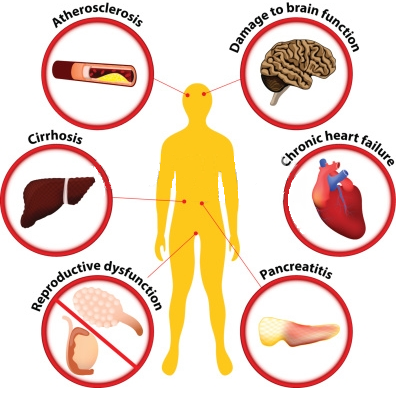Chapter 11: Adiction
In this Chapter
Alcohol
1Although legal, alcohol is addictive. Together, alcohol abuse and alcohol addiction — sometimes referred to as alcoholism or alcohol dependence — are among the nation’s major health problems. It is clear that genetic and environmental factors contribute to alcoholism, but at this point, no single factor or combination of factors enables doctors to predict who will develop an addiction to alcohol. Nearly17.6 million people abuse alcohol or are alcoholic. Fetal alcohol syndrome, affecting about 1 to 3 of every 1,000 babies born in the United States, is the leading preventable cause of mental retardation. Cirrhosis, or scarring of the liver, is the main chronic problem associated with alcohol addiction. Other chronic liver diseases are responsible for more than 29,000 deaths each year. The annual cost of alcohol abuse and addiction is estimated at $185 billion.
2Ethanol, the active ingredient in alcoholic beverages, is a seductive drug. At first, it reduces anxiety, tension, and behavioral inhibitions. In low doses, it may act as a stimulant, but at higher doses, it acts as a depressant. In both cases, it significantly alters mood and behavior. Too much alcohol can also cause heat loss and dehydration.
3The drug, which is easily absorbed into the bloodstream and the brain, affects several neurotransmitter systems. For example, alcohol’s interaction with the gamma-aminobutyric acid (GABA) receptor can calm anxiety, impair muscle control, and delay reaction time. At higher doses, alcohol also decreases the function of N-methyl-d-aspartate (NMDA) receptors, which recognize the neurotransmitter glutamate. This interaction can cloud thinking and eventually lead to coma.
4In addition, animal research has shown that alcohol works by activating the endogenous opioid system. This means that susceptible individuals may feel an opioid-like euphoria from their own endorphins when they drink. Earlier, a medication called naltrexone had been developed for heroin addiction, which also affects the opioid system. Naltrexone works by blocking opioid receptors. Researchers thought that this medication might be effective for alcoholics as well. Clinical trials began in 1983, and in 1995, the U.S. Food and Drug Administration (FDA) approved naltrexone for the treatment of alcoholism.
